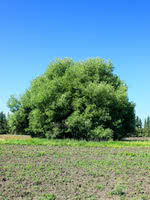Mon-Fri 9am - 5pm Mountain time
Acute Willow vs Black Locust
Salix acutifolia
Robinia pseudoacacia
Acute Willow is a very fast growing small tree that can reach growth rates of up to 6 feet per year. It's a great choice for developing a quick, hardy shelterbelt, windbreak, or privacy screen.
Acute Willow will grow multi-stemmed but can be pruned to a single stem for a smaller footprint. It prefers moist areas and requires almost no maintenance.
Willows are important to native pollinators each spring as they have higher amounts of pollen and nectar early each growing season when other food sources are scarce.
Black Locust is an attractive tree. Its distinctive leaves are made of about a dozen bright green leaflets. It also notable for its fragrant white flowers, which smell of citrus.
Black Locust can grow in many situations, but prefers dry areas with lots of sun. It is robust and is an excellent choice for establishing shade in dry, open areas.
Important note: Much of the Black Locust is toxic to humans and livestock, including seeds, bark, and leaves.
Acute Willow Quick Facts
Black Locust Quick Facts
In row spacing: 2.4 m (8 ft)

